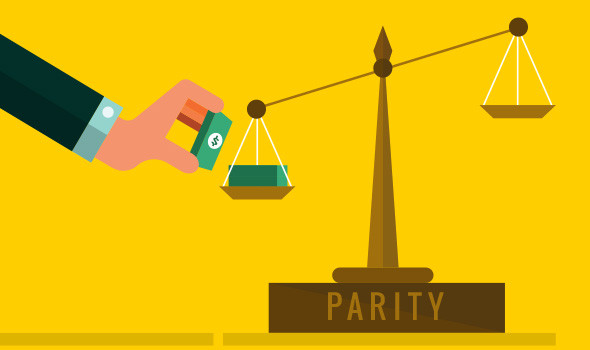
noun
- equality, as in amount, status, or character.
- equivalence; correspondence; similarity; analogy.
- Finance.
- equivalence in value in the currency of another country.
- equivalence in value at a fixed ratio between moneys of different metals.
- Physics.
- a property of a wave function, expressed as +1 or −1 and noting the relation of the given function to the function formed when each variable is replaced by its negative, +1 indicating that the functions are identical and −1 that the second function is the negative of the first.
- Also called intrinsic parity.a number +1 or −1 assigned to each kind of elementary particle in such a way that the product of the parities of the particles in a system of particles multiplied by the parity of the wave function describing the system is unchanged when particles are created or annihilated.
- a system of regulating prices of farm commodities, usually by government price supports, to provide farmers with the same purchasing power they had in a selected base period.
- Computers. the condition of the number of items in a set, particularly the number of bits per byte or word, being either even or odd: used as a means for detecting certain errors.
noun Obstetrics.
- the condition or fact of having borne offspring.
- para5(def 1).
noun plural -ties
- equality of rank, pay, etc
- close or exact analogy or equivalence
- finance
- the amount of a foreign currency equivalent at the established exchange rate to a specific sum of domestic currency
- a similar equivalence between different forms of the same national currency, esp the gold equivalent of a unit of gold-standard currency
- equality between prices of commodities or securities in two separate markets
- physics
- a property of a physical system characterized by the behaviour of the sign of its wave function when all spatial coordinates are reversed in direction. The wave function either remains unchanged (even parity) or changes in sign (odd parity)
- a quantum number describing this property, equal to +1 for even parity systems and –1 for odd parity systemsSymbol: P See also conservation of parity
- maths a relationship between two integers. If both are odd or both even they have the same parity; if one is odd and one even they have different parity
- (in the US) a system of government support for farm products
noun
- the condition or fact of having given birth
- the number of children to which a woman has given birth
n.1570s, “equality of rank or status,” from Middle French parité (14c.) or directly from Late Latin paritas “equality,” from Latin adjective par (genitive paris) “equal” (see pair (n.)). Meaning “condition in which adversaries have equal resources” is from 1955, originally in reference to the U.S.A. and the U.S.S.R. n.
- The state of having given birth to an infant or infants.
- The property of a physical system that entails how the system would behave if the coordinate system were reversed, each dimension changing sign from x, y, z to -x, -y, -z. If a system behaves in the same way when the coordinate system is reversed, then it is said to have even parity; if it does not, it is said to have odd parity. For bosons, the antiparticle of any given particle has the same parity, odd or even, as that particle. For fermions, the antiparticle has the opposite parity. See also conservation law parity conjugation.
- A quantum number, either +1 or -1, that mathematically describes this property.
- The number of 1’s in a piece of binary code, generally taken as the quality of odd or even rather than as a specific number. The parity of packets of binary data is often transmitted along with the data to help detect whether the value of any bits has been altered.
 Liberal Dictionary English Dictionary
Liberal Dictionary English Dictionary